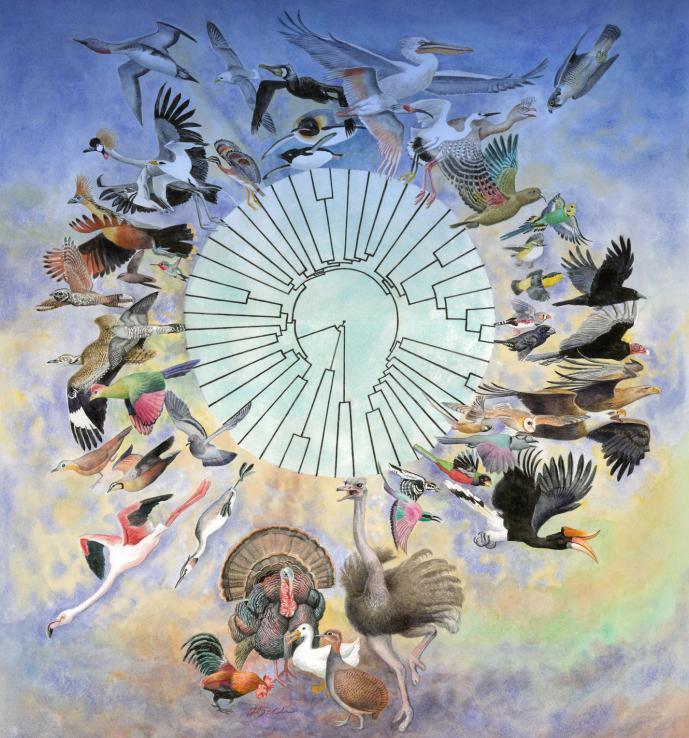
The new avian family tree based on whole genomes of 48 bird species representing all 30 neoavian orders and two galloanserae orders and two palaeognathae orders. The Avian Phylogenomics Consortium formally announces the launch of the Bird 10,000 genomes (B10K) project, an initiative to generate representative draft genome sequences from all extant bird species within the next five years. This will be the first attempt to sequence the genomes of all living species of a vertebrate class. The establishment of this project is built on the success of the previous ordinal level project, which provided the first proof of concept for carrying out large-scale sequencing of multiple representative species across a vertebrate class and a window into the types of discoveries that can be made with such genomes (1). The announcement of the B10K project is published online today in Nature.
The extraordinary diversity of Galapagos finches discovered during the 1826 voyage of the H.M.S. Beagle had an enormous impact on Darwin's thinking about 'On the Origin of Species'. His later studies on domesticated pigeons further inspired the development of the theory of evolution. Since then, bird studies have led to numerous pioneering findings that have established many new disciplines in biology, including Wallace's biogeography, Mayr's synthesis of speciation, MacArthur and Wilson's island biogeography, Tinbergen's ethology, and Hamilton's kinship theory. With about 10,500 living species, birds constitute the most speciose class of terrestrial vertebrates and are adapted to and distributed throughout most terrestrial and shallow aquatic biomes on the planet. Given these attributes, birds continue to be widely used as models for studies on population genetics, neurobiology, development and animal conservation. Moreover, domesticated birds contribute substantially to the World's food source and economy as in the form of eggs, meat, ornament and culture. In terms of world health, the spread of avian influenza, West Niles virus and other zoonotic or emerging infectious diseases has led to the loss of human lives. As pest in agriculture, some species result in loss of billions of dollars per year. Clearly, ornithology has had and will continue to have a pronounced impact on both basic scientific research and on biosecurity of human society.
In the past decade, we have witnessed the rapid development of genome sequencing technologies and the resultant wealth of knowledge from animal genomes. The phylogeny of birds has been one of the most challenging vertebrate groups to decipher. Recently, the ordinal level project, led by researchers from BGI, the University of Copenhagen, and Duke University (2), and including investigators from more than 20 countries, sequenced and/or collected the genomes from 48 bird species representing nearly all orders and covering a broad range of evolutionary diversity (3). The consortium was able to resolve much of the contested phylogenetic history of modern avian orders (4) (Fig. 1). This project also addressed an extensive array of questions regarding avian evolution, diversity and behavior (1). Due to this success, the consortium decided to expand the understanding and exploration of this unique class of vertebrates and extend these findings into multiple disciplines. To do so, the consortium has expanded and been reinforced through the addition of four more institutes as part of the leadership board: the Kunming Institute of Zoology in China; the Institute of Zoology of Chinese Academy of Science; the Smithsonian Institution in the USA; and the Center of Macroecology, Evolution and Climate in Denmark; they include experts in museum science, biogeography and ecology. These other contributing institutions and collaborators are listed in the B10K project website.
Given the small size and less complex features of bird genomes relative to other vertebrates, the ongoing advances in sequencing technologies, and the extensive availability of high quality tissue samples from birds deposited in museums around the world, reaching this ambitious goal is not only possible but also practical. In addition to contributing a large public genomic resource that will benefit the entire research community and human society, this project will include extensive collections of the morphological, physiological, ecological and behavioral traits of all species and will address a number of fundamental questions in evolution, ecology, and biodiversity.
The B10K project will allow the completion of a genomic level tree of life of the entire living avian class, decode the link between genetic variation and phenotypic variation, uncover the correlation of genetic evolutionary and biogeographical and biodiversity patterns across a wide-range of species, evaluate the impact of various ecological factors and human influence on species evolution, and unveil the demographic history of an entire class of organisms. Given all these aims, the consortium is carrying out the project in three phases. Each phase focuses on the completion of milestones at hierarchical levels of avian classification (Fig. 2). They envision this project will have significant scientific and public impact that will change the understanding of avian biology and evolution, which in turn will affect the understanding of other organisms and open doors to new areas of research.
Source: BGI Shenzhen
 Print Article
Print Article Mail to a Friend
Mail to a Friend
